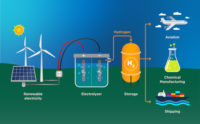States are set to gain $725 million a year in new funding authorized under the new infrastructure law to reclaim abandoned coal mines, the US Interior Dept. said on Feb. 7.
The law, passed last November, included $11.3 billion over 15 years for abandoned mine reclamation, significantly boosting the $8 billion spent on the program since its inception in 1977. The estimated cost to reclaim all abandoned U.S. sites is $20 billion.
States scheduled to get the most funding include Pennsylvania, with $245 million a year. West Virginia will get $140.7 million, Illinois will get $75.7 million and Kentucky will get $74.2 million.
The department will release in coming weeks detailed guidance for states to apply for funding.
In a 2021 report, advocacy group Appalachian Voices said that as the coal industry winds down in the U.S., the number of abandoned mines could increase dramatically. “How much reclamation obligation will be abandoned remains to be seen,” the report said.
“The impact of these dollars will depend on how [Interior] interprets the law and the guidance it provides to the implementing agencies,” says Chelsea Barns, legislative director for Appalachian Voices.
The $11.3 billion will be allocated under the abandoned mine land fund created by the 1977 Surface Mining Control and Reclamation Act.
U.S. Interior Secretary Deb Haaland says that states and Tribes can use the new funding to design, build, operate, maintain and rehabilitate acid mine drainage treatment facilities, a more flexible use of fundings than allowed currently under traditional abandoned mine land grants.
Under the infrastructure law, states are guaranteed at least $20 million over the program's 15-year life if their inventory of abandoned mines cost more than $20 million to reclaim.
New allotments could be adjusted as cleanup site inventories are updated, the department said.
The infrastructure law did not set funding priorities, “other than prioritizing projects that provide employment opportunities to former and current employees of the coal industry,” says a department spokesman, with states and tribes to develop their own cleanup site ranking strategy.
A coalition of more than a dozen advocates from coal mining regions recently released recommended approaches to eliminate hazards and restore damage and while also supporting “communities in economic transition.”
The group, led by North Carolina-based Appalachian Voices, asked the administration to clarify that funds may not be used for non-coal mine cleanup, —noting that the Interior Dept.'s Inspector General in 2017 found that states often did not give coal-related reclamation projects top priority over other projects.
Appalachian Voices also asked that guidance “prioritizes the creation of decent and living-wage jobs in coal communities and for coal miners.” Reclamation work funded by the allocation should offer prevailing wages and projects should be aggregated to attract union bids on contracts, the group said.
The group also asked that sites emitting methane be upgraded to the highest priority.





